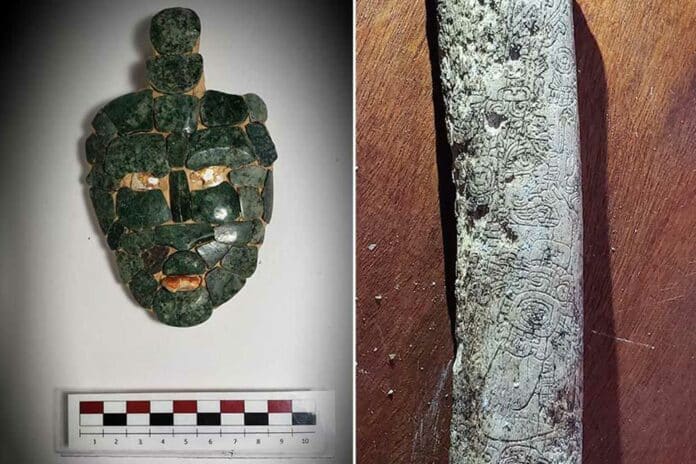A Tulane University archaeologist has recently discovered an ancient Maya tomb dating back 1,700 years at the site of Chochkitam in Guatemala near the borders of Mexico and Belize.
The tomb’s remarkable funeral offerings, such as a mosaic jade mask, rare mollusk shells, and writings carved in human femur bones, provide valuable insights into Maya civilization. The discovery includes depictions of a previously unknown king believed to be holding a jade mask similar to the one found in the tomb.
Hieroglyphs on the artifact are thought to connect the ruler to the Maya states of Tikal and Teotihuacan, providing historical and genealogical information.
This discovery is like winning the lottery in terms of information. It opens a window into an obscure time we have little texts about. The newly discovered tomb from the Maya classic period, dating from 250-900 AD, is a significant find given the limited remnants from this era, primarily affected by looting.
The tomb, located just 2 meters away from where looters had previously stopped, is remarkably well-preserved, with minimal damage aside from the natural decay and the collapse of the stone ceiling. This fortunate preservation provides archaeologists with a rare opportunity to explore the rich history and offerings within the tomb.
Estrada-Belli, a research assistant professor in the Tulane University School of Liberal Arts, said, “That was the first amazing thing about it. It was fortunate.”
Lidar technology played a crucial role in the tomb’s discovery by enabling archaeologists to detect looters’ tunnels and map the jungle floor precisely. This advanced technology, akin to ‘taking x-rays of the jungle floor,’ revolutionizes archaeological exploration, allowing researchers to navigate more efficiently through dense vegetation.
The tomb’s contents, including over 16 rare spondylus shells, provide valuable insights into ancient Maya practices, emphasizing their significance in royal contexts as symbols of wealth and elements used in religious and sacrificial ceremonies.
The relics from the tomb, dating back to 350 CE, establish a historical link between Tikal and the central Mexican site of Teotihuacan. This connection sheds light on the cultural exchanges and influences between Maya rulers and the wider Mesoamerican region during the Maya classic period.
The tomb’s contents, including a mosaic jade mask and hieroglyphs carved on human femur bones, offer insights into religious practices and royal lineage, enriching our understanding of ancient Maya civilization. The discovery at Chochkitam, after a century since Fran Blom’s initial exploration, underscores the significance of continued archaeological efforts.
Marcello A. Canuto, MARI director and Tulane archaeologist specializing in the Maya archaeology, said, “All of Indigenous America has a deep and complex history. For this reason, Tulane recognized early on that it was important and worthy of serious and focused academic interest. Discoveries like this one, including those made by other Tulane faculty and students conducting fieldwork, represent Tulane’s commitment to studying ancient indigenous American peoples and their accomplishments.”
Estrada-Belli said the next stage in his work at the site will be to conduct DNA testing on the bones and maybe uncover additional essential contents buried within the abandoned pyramid.
